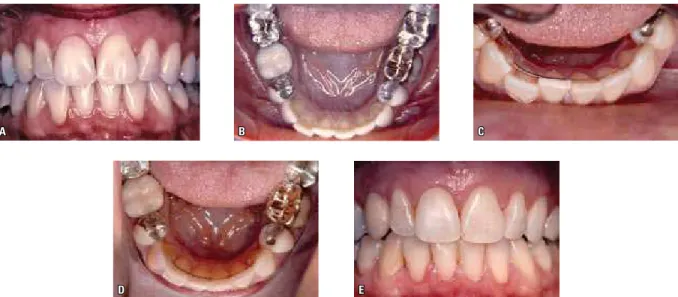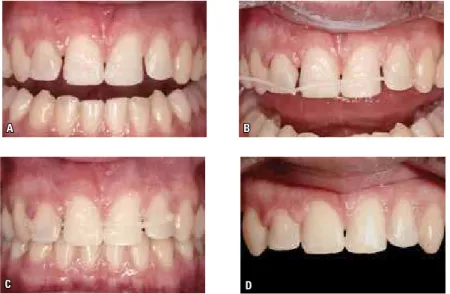David Normando*, Leopoldino Capelozza Filho**
A method to re-treat the relapse of
dental misalignment
The clinician should expect some loss of the dental alignment obtained during orthodontic therapy in the long term in cases in which the orthodontic retainer has been removed by the orthodontist or lost by the patient. In this situation, patients are often reluctant to wear braces again to re-treat anterior misalignment. This report describes the successful use of a simple and effective technique to correct mild changes in the incisor alignment after orth-odontic treatment. An innovative and low cost procedure effectively solved the relapse of anterior misalignment in 1-2 months. The force used to realign the teeth is obtained through the use of a clear elastomeric thread tied to multistranded upper and lower retainers. Abstract
Keywords: Tooth movement. Orthodontic appliances. Incisor. Relapse.
* Professor of Orthodontics, School of Dentistry - UFPA. Coordinator of the Specialization Program in Orthodontics, ABO-PA. MSc in Integrated Clinic, FOUSP. PhD in Orthodontics, Rio de Janeiro State University (UERJ). Specialist in Orthodontics, PROFIS-USP/Bauru.
** PhD Professor, Bauru Dental School, University of São Paulo (USP). Member of the Orthodontic Division of the HRAC-USP.
How to cite this article: Normando D, Capelozza Filho L. A method to
re-treat the relapse of dental misalignment. Dental Press J Orthod. 2011 Sept-Oct;16(5):48-53.
» The authors report no commercial, proprietary, or inancial interest in the
INTRODUCTION
Follow-up studies of treated cases have shown that although ideal occlusion and den-tal alignment have been achieved, there is a tendency for post-treatment relapse toward the original malocclusion.1-4 Furthermore, pa-tient’s satisfaction is moderately associated with the stability of the orthodontic treatment5 while the use of retainers is one important fac-tor related to treatment stability.4 Therefore, preserving dental alignment can contribute to a higher level of satisfaction in patients who have undergone orthodontic treatment.
The most effective way to re-treat mandib-ular anterior crowding or spacing after reten-tion requires the use of brackets and archwires. However, patients are often reluctant to wear braces again for the purpose of aligning the af-fected teeth. Several alternatives have been pro-posed for tooth realignment, which may involve the use of an active removable appliance,6-10 re-tention with lingual spurs11 or the use of nickel-titanium archwires as retention devices.12 An innovative technique that involves an already installed retainer and a clear elastomeric solid thread is presented in this paper.
TeChNIqUe PReseNTATION
The use of fixed lower retainers is a routine in the orthodontic clinic14 and its efficiency has been widely reported in the orthodontic litera-ture.4,13 However, the use of fixed upper re-tainers does not seem as popular among ortho-dontists. Thus, orthodontists routinely make use of a removable Hawley plate to retain the alignment of the upper dental arch, while for the lower arch bonded 3X3 retainer seems to be the first option.14,15 This choice seems to be based on the fact that relapse seems less frequent in the upper arch compared to the
the fracture risks due to incisal contact during mastication. Although misalignment is more frequent in the lower arch, it seems reason-able to believe that the instability of the up-per arch causes more dissatisfaction for the patient, specially in cases where there is more esthetical exposure during smiling. Moreover, the effective bonding of an upper retainer re-quires additional care during the placement of the wire, which must be below the proximal contact points. However, a previous study16 has demonstrated excellent long-term success rates for upper and lower fixed retainers.
The technique presented in this paper re-quires the use of fixed retainers in both arches. It also seems important the use of multi-stranded wires, co-axial type, made of stainless steel with 0.021-in in diameter due to the excellent stabili-ty15 and surface roughness, which allows the wire to hold the elastomeric solid thread that will generate the necessary force to move the teeth. The direction of this force will be defined by the placement of the elastomeric thread in relation to the fixed retainer. This thread should be changed every two weeks. Thus, it is possible to correct labial displacements (Fig 1), tooth rotation (Fig 2) and spacing (Fig 3) in the upper and/or lower dental arches. However, it should be noted that in most cases of incisor labial displacement, it is necessary to create more space, which can be done by interproximal striping (Fig 1).
CAse RePORTs
Three clinical cases are used to illustrate the technique presented in this paper. They are representative cases of dental misalignment af-ter fracture or loss of a bonded retainer.
A B
D
C
E
A B
D C
FIGURE 1 - Adult patient, 20 years after the orthodontic treatment, reported a mild labial displacement of tooth 42 (A) causing premature contact in MHI with tooth 12 (B) and consequent wear of its incisal edge. A lingually bonded lower retainer made of stainless steel co-axial multi-stranded wire, 0.0215-in in diameter (Penta-one Masel Orthodontics, Carlsbad, CA) was bonded to all lower anterior teeth except tooth 42. The 0.020-in elastomeric solid thread (Masel Orthodontics, Carlsbad, CA) was tied to tooth 42, which generated a force to move this tooth lingually (C). A slight stripping was necessary in the adjacent teeth in order to provide some space. The tooth was repositioned after 45 days. The solid thread was changed every two weeks (D, E).
A B
D C
E
A B
D C
FIGURE 3 - Reopening space at the mesial of the upper lateral incisors after maxillary retainer bonding fracture (A). The retainer was still bonded to the upper canines and upper central incisors. A knot was made at the end of the solid thread (B) and this knot was bonded with composite to the labial surface of the upper left lateral incisor. The elastomeric thread was pulled and bonded to the upper right lateral incisor. The space was closed in just 10 days and the upper lateral incisors were rebonded to the upper retainer.
DIsCUssION
Treatment stability has been the main goal of orthodontics, although it is well known that treatment outcomes are not stable at all since a multiplicity of factors can interfere in the post-treatment occlusal balance leading to un-desirable changes. Despite numerous published studies, a systematic review17 reports that there is insufficient research data on which to base our clinical practice choices on retention.
The risk of relapse in the anterior segment compared to the posterior4 is the clinical in-dication for a fixed lower anterior retainer. Multistranded wires has been proposed for the construction of fixed retainers based on their ability to allow for the physiologic movement of the teeth, whereas their surface offers in-creased mechanical retention for the adhe-sive.18,19 Despite multistranded retainers are ef-ficient in preventing relapse of the mandibular anterior teeth,20 post-treatment changes in the mandibular anterior teeth are expected when bonding failure occurs.1-4
Longitudinal studies of orthodontically treated cases have demonstrated a tendency for relapse after treatment1-4, even in well fin-ished cases. These changes may occur suddenly in cases of loss or fracture of retainers. Even though the most effective manner for orth-odontic retreatment of crowding or diastemas require the use of brackets and wires for level-ing, the advantage of using a simpler, faster and cheaper procedure would by itself justify the adoption of this method. The technique de-scribed in this paper apart from being effective
seems to be better accepted by the patient be-cause of the little time spent in retreatments and the low impact on esthetics. However, it requires the orthodontist to use fixed retainers for both dental arches. This approach is able to correct several minor changes postretention, such as buccal inclinations of the incisors (Fig 1), anterior rotations (Fig 2) and interincisal diastema (Fig 3) of anterior teeth.
Even though it is efficient for the correction of minor alterations, typical of misalignments in the anterior region of dental arch, it should be emphasized that major changes appear to be handled more efficiently with fixed appliances. In this case, the professional will have to sur-pass the usual patient resistance, who, general-ly, fights against using brackets and orthodontic wires or search for other alternative ways to perform re-treatment. Nevertheless, the dis-advantage of installing fixed appliances once again for the correction of minor movements seems to perfectly be replaced by the method described in this paper.
CONClUsION
1. Erdinc AE, Nanda RS, Isiksal E. Relapse of anterior crowding in patients treated with extraction and nonextraction of premolars. Am J Orthod Dentofacial Orthop. 2006;129(6):775-84.
2. Freitas KM, Freitas MR, Henriques JF, Pinzan A, Janson G. Postretention relapse of mandibular anterior crowding in patients treated without mandibular premolar extraction. Am J Orthod Dentofacial Orthop. 2004;125(4):480-7.
3. Little RM. Stability and relapse of mandibular anterior alignment: University of Washington studies. Semin Orthod. 1999;5(3):191-204.
4. Maia NG, Normando ADC, Maia FA, Alves MSC, Ferreira MAF. Factors associated with orthodontic stability: a retrospective study of 209 patients. World J Orthod. 2010;11(1):61-6.
5. Maia NG, Normando D, Maia FA, Ferreira MA, Alves SCFM. Factors associated with long-term patient satisfaction. Angle Orthod. 2010;80(6):1155-8.
6. Warunik SP, Strychalski ID, Cunat JJ. Clinical use of silicone elastomer appliances. J Clin Orthod. 1989;23(10):694-700. 7. Sheridan JJ, McMinn R, LeDoux W. Essix thermosealed
appliances: various orthodontic uses. J Clin Orthod. 1995;29(2):108-13.
8. Rinchuse DJ, Rinchuse DJ. Active tooth movement with Essix-based appliances. J Clin Orthod. 1997;31(2):109-12. 9. Cureton SL. Correcting maligned mandibular incisors with
removable retainers. J Clin Orthod. 1996;30(7):390-5. 10. Bloore JA, Bloore GE. Correction of adult incisor
crowding with a new removable appliance. J Clin Orthod. 1998;32(2):111-6.
RefeReNCes
11. McNamara TG, McNamara T, Sandy JR. A new approach to incisor retention-the lingual spur retainer. Br J Orthod. 1996;23(3):199-201.
12. Liou EJW, Chen LIJ, Huang S. Nickel-titanium mandibular bonded lingual 3-3 retainer: For permanent retention and solving relapse of mandibular anterior crowding. Am J Orthod Dentofacial Orthop. 2001;119(4):443-9.
13. Årtun J, Spadafora AT, Shapiro PA. A 3-year follow-up study of various types of orthodontic canine-to-canine retainers. Eur J Orthod. 1997;19(5):501-9.
14. Valiathan M, Hughes E. Results of a survey-based study to identify common retention practices in the United States. Am J Orthod Dentofacial Orthop. 2010;137(2):170-7. 15. Singh P, Grammati S, Kirschen R. Orthodontic retention
patterns in the United Kingdom. J Orthod. 2009;36(2):115-21. 16. Tacken MP, Cosyn J, De Wilde P, Aerts J, Govaerts E, Vannet
BV. Glass ibre reinforced versus multistranded bonded
orthodontic retainers: a 2 year prospective multi-centre study. Eur J Orthod. 2010;32(2):117-23.
17. Littlewood SJ, Millett DT, Doubleday B, Bearn DR, Worthington HV. Retention procedures for stabilizing tooth position after treatment with orthodontic braces. Cochrane Database Syst Rev. 2004;(1):CD002283.
18. Zachrisson BU. Clinical experience with direct-bonded orthodontic retainers. Am J Orthod 1977;71(4):440-8. 19. Zachrisson BU. The bonded lingual retainer and multiple
spacing of anterior teeth. J Clin Orthod. 1983;17(12):838-44. 20. Katsaros C, Livas C, Renkema AM. Unexpected
complications of bonded mandibular lingual retainers. Am J Orthod Dentofacial Orthop. 2007;132(6):838-41.

